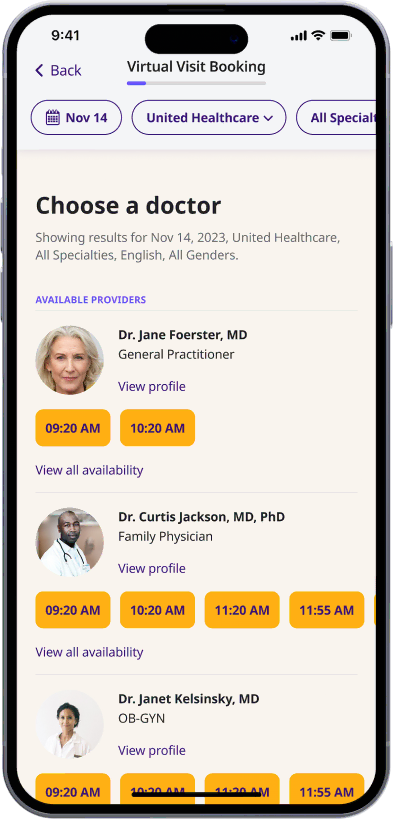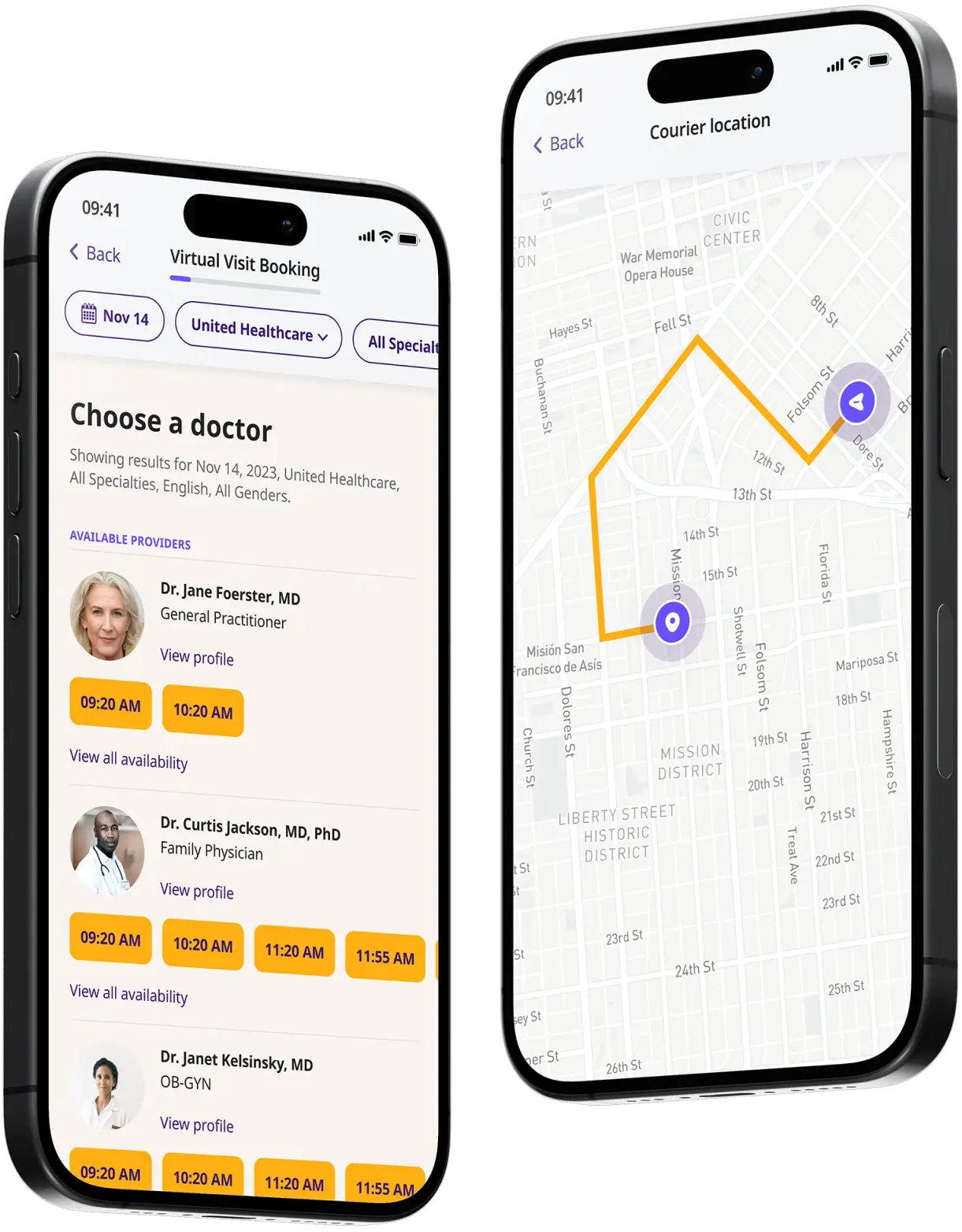Get a Doxycycline Prescription Online
Consult with a doctor online to get a doxycycline prescription or refill for infections or other conditions.


Available in 50 states. Insurance accepted.
Fast
virtual visits
24/7 care
assistants
Prescriptions
as needed



See If Delivery Is Available Near You
Delivery Not Available
Enter your ZIP code to check if prescription delivery is available in your area and how soon your meds could arrive.
How to get started
Choose your doctor, start a virtual visit, and have your prescriptions sent to your preferred pharmacy for pickup — all in just a few easy steps.
Choose a doctor
Choose a physician by availability, specialty, ratings, and more.

Start a video call
Get connected with a doctor anytime, anywhere.

1-Hour Rx Delivery
Your prescription delivered to your door in 1 hour or less.

Available in 50 states. Insurance accepted.
One-Time
Physician Visit
One-time visit with a physician for diagnosis, treatment, Rx, labs, referrals, and doctor’s notes.
Accepted Insurances
See why people turn to DrHouse...
As seen in

Doxycycline
Doxycycline is a prescription antibiotic used to treat a wide variety of infections, including chest, dental, skin, and sexually transmitted infections. It’s one of the most widely prescribed antibiotics in the United States, with millions of people taking the medication each year.
The list of conditions that doxycycline is used for is extensive. You may take it if you have acne or an eye infection or if you get an infection from contaminated water. It’s even used to prevent malaria and treat anthrax.
It comes in a variety of forms, including tablets, capsules, and dissolvable tablets that you take with water. The treatment period is relatively short, with most people beginning to feel better after a few days of starting the course of antibiotics, but it’s important to take the full course, even if you’re no longer showing symptoms.
Generic brand names for doxycycline include Vibramycin, Monodox, Oracea, Doryx, Adoxa, and Periostat.
What Is Doxycycline Prescribed For?
Doxycycline is a highly versatile, broad-spectrum antibiotic that treats a wide range of bacterial infections. It’s commonly prescribed for conditions such as:
- Upper respiratory infections – Effective for pneumonia, bronchitis, and sinus infections.
- Skin conditions – Frequently used for acne, rosacea, and cellulitis.
- Sexually transmitted infections (STIs) – Treats chlamydia, syphilis, and gonorrhea.
- Tick-borne illnesses – Prevents and treats Lyme disease, Rocky Mountain spotted fever, and other tick-related infections.
- Urinary tract infections (UTIs) – Used in specific cases, especially when other antibiotics aren’t suitable.
- Dental infections – Addresses abscesses and other oral bacterial infections.
- Malaria prevention – Prescribed for travelers to high-risk areas.
- Eye infections – Treats bacterial conjunctivitis and other ocular conditions.
This antibiotic is particularly beneficial for people allergic to penicillin and offers a fast-acting solution for bacterial infections.
How Does Doxycycline Work?
Doxycycline is a type of tetracycline antibiotic. These antibiotics work by targeting the bacteria that are causing the infection and preventing them from growing.
More specifically, the medication stops the bacteria from producing the protein they need to survive. That’s how it works when it’s used as part of treatment against interior infections. For bacterial conditions like acne, it reduces the volume of bacteria on the surface of the skin.
What Are the Side Effects of Doxycycline?
Most people who take doxycycline won’t experience any serious side effects. However, as with every other type of medication, there are mild side effects that are more common.
Studies have shown that around one in ten people who take doxycycline will experience side effects to varying degrees.
The most common side effects include:
- Nausea
- Headaches
- Loss of appetite
- Light sensitivity
- Bloating or indigestion
- Dry mouth
- Fatigue
- Rash
- Teeth discoloration
Though it’s rare, some people do experience more severe side effects. These can include:
- Severe or bloody diarrhea
- Fever
- Dehydration
- Blistered or peeling skin
- Joint pain
- Chest pain
If you experience any of the above contact your doctor immediately as these can be serious and require medical attention. If you experience any chest pain or difficulty breathing, then seek emergency medical attention as soon as possible.
Pros and Cons of Doxycycline
Like any medication, doxycycline has its advantages and potential drawbacks. Understanding the pros and cons of doxycycline can help you decide if it’s the right treatment for your condition. Always consult a licensed doctor for guidance tailored to your needs.
Pros:
- Effective against a broad range of bacterial infections, including respiratory infections, acne, and STIs.
- Can prevent conditions like malaria and treat tick-borne illnesses, such as Lyme disease.
- Available in various forms (tablets, capsules, and dissolvable tablets) for easy administration.
- An excellent alternative for patients allergic to penicillin.
- Short treatment duration for most infections.
Cons:
- Not recommended for children under 8, pregnant women, or those who are breastfeeding.
- Can cause side effects like nausea, light sensitivity, and digestive upset.
- Timing is critical when consuming dairy products, supplements, or certain medications to avoid reduced effectiveness.
- Prescription-only, meaning it cannot be purchased over the counter.
- May interact with other medications, so full disclosure to your doctor is essential.
Discuss your symptoms with a licensed doctor to determine if doxycycline is the best option for you and learn how to minimize potential side effects.
Why Choose DrHouse for Your Doxycycline Prescription?
DrHouse makes getting prescriptions online fast, simple, and convenient. Whether you need treatment for a bacterial infection or advice on preventive care, our licensed doctors are available 24/7 to assist you.
Here’s how DrHouse works:
- Start your virtual consultation – Log in to the DrHouse app and connect with a physician in minutes.
- Discuss your symptoms – Share your medical history and symptoms for a personalized evaluation.
- Get your prescription – If deemed appropriate, your doctor will send your doxycycline prescription directly to your preferred pharmacy.
With DrHouse, there’s no need for clinic visits or waiting rooms. Enjoy high-quality, confidential care from the comfort of your home. So don’t wait—start your online consultation now and get the care you need!
Frequently Asked Questions About Doxycycline
Is Doxycycline Considered a Strong Antibiotic?
While the term “strong” is relative and somewhat misleading, because the efficacity of antibiotics is highly dependent on the type of infection and bacteria it’s being used against as well as the location of the actual infection.
But doxycycline is a broad-spectrum antibiotic, which means it is effective against a wide range of infections. This makes it versatile for treating various kinds of infections.
What Are the Most Common Side Effects of Doxycycline?
The most common side effects of Doxycycline are nausea, headaches, light sensitivity, loss of appetite, and bloating.
Note that the mentioned side effects are just some of the most common ones. There are also more serious, less common side effects that you should be aware of. These include severe or bloody diarrhea, fever, dehydration, blistered or peeling skin, and joint pain.
For a complete overview of side effects, always read the information leaflet that comes with your medication and ask your doctor or pharmacist if you have any questions.
Can I Go in the Sun While Taking Doxycycline?
Doxycycline can increase your sensitivity to sunlight, making you more prone to sunburn. It’s recommended to wear sunscreen, protective clothing, and avoid prolonged sun exposure while taking this medication.
Does Doxycycline Cause Yeast Infections?
Yes, doxycycline can disrupt the balance of good and bad bacteria in your body, potentially leading to yeast infections. If you notice symptoms like itching or unusual discharge, consult your doctor for treatment options.
How to Take Doxycycline?
How you take doxycycline will depend on why it has been prescribed to you. Typically doses are 100mg – 200mg, taken once or twice a day. If taking more than once a day, you should take one dose when you wake up and one when you go to bed.
For some conditions, the dose will be 40 mg, taken once a day. You can take it with or without food, though it’s sometimes recommended to take it with food because it reduces the chance of nausea.
Many people begin to feel better after a few days of taking doxycycline. However, as with all antibiotics, it’s important that you complete the full course of medication.
What Is the Typical Dosage for Doxycycline?
The dosage of doxycycline depends on the condition you are using it to treat. Typically, the dosage is 100mg – 200 mg per day, taken orally. In some cases, such as for the treatment of acne or rosacea, a lower dose may be prescribed (40 mg per day).
It’s important to take the medication as prescribed by your doctor or pharmacist. You should not increase or decrease the dosage without consulting a medical professional first.
Who Should Not Take Doxycycline?
While doxycycline is a relatively safe antibiotic, there are certain people who should not take it such as pregnant women, breastfeeding women, people allergic to tetracycline antibiotics, and children under the age of 8.
Consult with your doctor if you are unsure whether or not doxycycline is safe for you.
What to Avoid While Taking Doxycycline?
There are some medications that will negatively interact with doxycycline. These include:
- Other antibiotics
- Warfarin
- Some acne medicines
- Ciclosporin
It’s also important to tell your healthcare provider if you’re taking supplements that include zinc, aluminum, calcium, or magnesium. You should also avoid consuming dairy products at the same time you take the medication (wait a few hours).
Also, note that the mentioned foods and medications are just some of the things to avoid while taking doxycycline. Before beginning any medication, always consult with your pharmacist or doctor for a complete list of what to avoid.
How Long Does It Take for Doxycycline to Work for Bacterial Infections?
Most people start feeling better within 48-72 hours of starting doxycycline. However, it’s essential to complete the full course of antibiotics, even if your symptoms improve, to ensure the infection is fully treated.
What Is Doxycycline Mono?
Doxycycline mono refers to doxycycline monohydrate, a specific form of the antibiotic. It is equally effective as doxycycline hyclate and commonly used to treat bacterial infections like acne, respiratory infections, and STIs.
How Long Does Doxycycline Stay in Your System?
Doxycycline typically remains in your system for about 5-6 days after your last dose. This depends on your metabolism, dosage, and duration of treatment. Always complete your prescribed course as directed by your doctor.
Can You Get Doxycycline Over-The-Counter (OTC)?
No, Doxycycline is not available over-the-counter. You’ll need a prescription from a licensed healthcare provider to get doxycycline.
Can You Get Doxycycline Online?
Yes, you can get an online prescription for doxycycline from DrHouse if deemed appropriate after a virtual consultation with our licensed physicians.
How to Get a Doxycycline Prescription Online?
At DrHouse, getting a doxycycline prescription online is simple and convenient. Start by downloading and opening the DrHouse telehealth app to connect with an online doctor within minutes. During your virtual consultation, you’ll discuss your symptoms, medical history, and any concerns with the doctor. If the doctor determines that doxycycline is appropriate for your condition, they will issue a prescription, which will be sent directly to your preferred pharmacy. With DrHouse, you can skip the clinic and access affordable, high-quality healthcare from the comfort of your home, 24/7.
For more detailed information about doxycycline, you can refer to the following sources:
- Doryx prescription label, Food and Drug Administration (FDA).
- Doxycycline, Drugs.com.
- Doxycycline, MedlinePlus.
The content on this page has been medically reviewed for accuracy and comprehensiveness by Amy Dougherty, FNP-BC, AGAC
Related services
Explore more of our services tailored to your needs and discover additional ways we can support your healthcare needs.
Frequently asked questions



